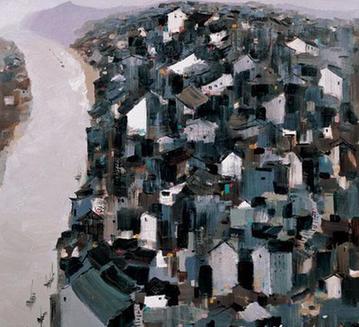 |
|
Wu Guangzhong's painting |
Wu Guangzhong, who refused to bow to tradition and convention, is an acknowledged master who combines abstractionism with Oriental art and melds Western principles with Eastern sensibility.
A retrospective of around 160 of his works is featured at the Shanghai Museum through February 20. The exhibit fills three halls.
Rarely has a single painter been so honored.
But then, Wu, now 90, was the first living Chinese painter whose works were exhibited in the British Museum.
The works are on loan from five art museums, including the Singapore Art Museum, the Hong Kong Art Museum and the Shanghai Art Museum. Wu himself, who lives in Beijing, donated 87 of the works to Shanghai Art Museum.
"This makes our collection of Wu's work the richest in China," says Li Lei, director at Shanghai Art Museum.
Though he was suffering from the flu, Wu insisted on being present at the opening of his solo show.
Asked about his donation to the Shanghai Art Museum, Wu replied: "Shanghai is famous for its tradition of receiving new things. I believe the Shanghai Art Museum has the potential to become one of the top art museums."
Perhaps compared with his peers, heavyweight names like Zao Wou-ki and Chu Teh-chun - already famous in Europe in the early 1970s - Wu received his laurels accolades rather late. He doesn't seem to care.
 |
|
Wu Guangzhong's painting |
Born in 1919 in Yixing County, Jiangsu Province, Wu comes from a rural country in the south, often referred to as the "country of fish and rice."
Wu's works reflect his early memories of his simple hometown and rugged life. Rough open fields, irrigation ditches and farmlands are painted with nostalgia for simpler bygone days.
Wu wrote in his biography that Vincent van Gogh, a genius of the 19th century, was a "saint" of art.
"Since I began to learn painting from my youth, I fell love with van Gogh's works as soon as I saw them. The love has lasted until now and never recedes at all," says the old man.
The artistic brilliance in van Gogh's bitter life inspired and warmed Wu's heart in his youth, deeply marking his later spiritual course in art.
"When I was painting a series of crops in the field with the bright sun burning on me, I experienced the same flames burning in van Gogh's heart at that moment," he recalls.
Wu had distinct ideas about artistic traditions, and he questioned traditional ink painting skills, such as light-ink strokes, tracing methods and the integration of poetry, calligraphy and painting in contemporary ink painting.
His sensitivity to (meaning his rejection of) formal composition is reflected in his paintings, together with bright colors and light - all are his hallmark. His sensitivity to color and the rhythm of dots and lines combines the essence of Oriental content and Western technique.
"Wu never painted to advocate a certain policy, to express a certain opinion, or to commemorate a certain event," says Jiang Mei, curator of the exhibit. "Instead, he explores the possibilities of forms in creating a sentimental atmosphere and developing a conceptual perspective.
"His importance in Chinese art history lies in his shattering all the bonds."
Date: through February 20, 9am-4pm
Address: 325 Nanjing Rd W.
Admission: 20 yuan
Tel: 6327-2829
(Shanghai Daily January 23, 2009)